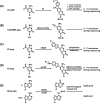Quantification and mapping of DNA modifications
- PMID: 34458826
- PMCID: PMC8341653
- DOI: 10.1039/d1cb00022e
Quantification and mapping of DNA modifications
Abstract
Apart from the four canonical nucleobases, DNA molecules carry a number of natural modifications. Substantial evidence shows that DNA modifications can regulate diverse biological processes. Dynamic and reversible modifications of DNA are critical for cell differentiation and development. Dysregulation of DNA modifications is closely related to many human diseases. The research of DNA modifications is a rapidly expanding area and has been significantly stimulated by the innovations of analytical methods. With the recent advances in methods and techniques, a series of new DNA modifications have been discovered in the genomes of prokaryotes and eukaryotes. Deciphering the biological roles of DNA modifications depends on the sensitive detection, accurate quantification, and genome-wide mapping of modifications in genomic DNA. This review provides an overview of the recent advances in analytical methods and techniques for both the quantification and genome-wide mapping of natural DNA modifications. We discuss the principles, advantages, and limitations of these developed methods. It is anticipated that new methods and techniques will resolve the current challenges in this burgeoning research field and expedite the elucidation of the functions of DNA modifications.
This journal is © The Royal Society of Chemistry.
Conflict of interest statement
The authors declare no competing financial interest.
Figures








Similar articles
-
Assessment of DNA Epigenetic Modifications.Chem Res Toxicol. 2020 Mar 16;33(3):695-708. doi: 10.1021/acs.chemrestox.9b00372. Epub 2019 Nov 20. Chem Res Toxicol. 2020. PMID: 31690070 Review.
-
Detection and Application of 5-Formylcytosine and 5-Formyluracil in DNA.Acc Chem Res. 2019 Apr 16;52(4):1016-1024. doi: 10.1021/acs.accounts.8b00543. Epub 2019 Jan 22. Acc Chem Res. 2019. PMID: 30666870
-
Deciphering Epigenetic Cytosine Modifications by Direct Molecular Recognition.ACS Chem Biol. 2015 Jul 17;10(7):1580-9. doi: 10.1021/acschembio.5b00158. Epub 2015 May 1. ACS Chem Biol. 2015. PMID: 25897631 Review.
-
Epitranscriptomics: regulation of mRNA metabolism through modifications.Curr Opin Chem Biol. 2017 Dec;41:93-98. doi: 10.1016/j.cbpa.2017.10.008. Epub 2017 Nov 7. Curr Opin Chem Biol. 2017. PMID: 29125941 Review.
-
Quantifying m6A and Ψ Modifications in the Transcriptome via Chemical-Assisted Approaches.Acc Chem Res. 2023 Nov 7;56(21):2980-2991. doi: 10.1021/acs.accounts.3c00436. Epub 2023 Oct 18. Acc Chem Res. 2023. PMID: 37851547
Cited by
-
Unprecedented reactivity of polyamines with aldehydic DNA modifications: structural determinants of reactivity, characterization and enzymatic stability of adducts.Nucleic Acids Res. 2023 Nov 10;51(20):10846-10866. doi: 10.1093/nar/gkad837. Nucleic Acids Res. 2023. PMID: 37850658 Free PMC article.
-
Epigenetic Regulation of Ferroptosis in Central Nervous System Diseases.Mol Neurobiol. 2023 Jul;60(7):3584-3599. doi: 10.1007/s12035-023-03267-1. Epub 2023 Feb 27. Mol Neurobiol. 2023. PMID: 36847936 Review.
-
Bisulfite-free and single-nucleotide resolution sequencing of DNA epigenetic modification of 5-hydroxymethylcytosine using engineered deaminase.Chem Sci. 2022 May 26;13(23):7046-7056. doi: 10.1039/d2sc01052f. eCollection 2022 Jun 15. Chem Sci. 2022. PMID: 35774177 Free PMC article.
-
Direct sequencing of DNA 5-methylcytosine by engineered dioxygenase NTET-assisted eNAPS.Chem Sci. 2025 Jul 11;16(32):14800-14810. doi: 10.1039/d5sc03634h. eCollection 2025 Aug 13. Chem Sci. 2025. PMID: 40687699 Free PMC article.
-
Labeling and sequencing nucleic acid modifications using bio-orthogonal tools.RSC Chem Biol. 2022 Jun 22;3(8):994-1007. doi: 10.1039/d2cb00087c. eCollection 2022 Aug 3. RSC Chem Biol. 2022. PMID: 35975003 Free PMC article. Review.
References
-
- Zhao Y. Zuo X. Li Q. Chen F. Chen Y. R. Deng J. Han D. Hao C. Huang F. Huang Y. Ke G. Kuang H. Li F. Li J. Li M. Li N. Lin Z. Liu D. Liu J. Liu L. Liu X. Lu C. Luo F. Mao X. Sun J. Tang B. Wang F. Wang J. Wang L. Wang S. Wu L. Wu Z. S. Xia F. Xu C. Yang Y. Yuan B. F. Yuan Q. Zhang C. Zhu Z. Yang C. Zhang X. B. Yang H. Tan W. Fan C. Sci. China: Chem. 2021;64:171–203. - PMC - PubMed
-
- Mark B. McGouran J. F. Nat. Rev. Chem. 2018;2:332–348.
-
- Liu T. Ma C. J. Yuan B. F. Feng Y. Q. Sci. China: Chem. 2018;61:381–392.
-
- Greenberg M. V. C. Bourc'his D. Nat. Rev. Mol. Cell Biol. 2019;20:590–607. - PubMed
-
- Rausch C. Hastert F. D. Cardoso M. C. J. Mol. Biol. 2020;432:1731–1746. - PubMed
Publication types
LinkOut - more resources
Full Text Sources
Other Literature Sources

